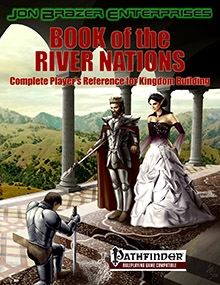Book of the River Nations: Complete Player’s Reference for Kingdom Building
Book of the River Nations is a supplement for the Pathfinder Roleplaying Game published by Jon Brazer Enterprises.
By Dale C. McCoy, Jr.

Welcome to the twenty-seventh Designer’s Diary, a regular column where designers are given the opportunity to take readers on an in-depth ride through the design and development process of their system, setting, or product. If you’d like to share your product in the Designer’s Diary column, send a message to aaron@roleplayerschronicle.com.
Designer’s Description
The Book of the River Nations: Complete Player’s Reference for Kingdom Building is a book of new options for the Pathfinder Roleplaying Game. The assumed game for Pathfinder (and its predecessor, Dungeons and Dragons) is to go on adventures, kill monsters, get lots of cool stuff and save the world in the process. But what happens when you save the world (or a country or a town) and the people look to your characters for leadership? The basic rules do not provide much in the way of support. This is where the Book of the River Nations comes in. The book contains rules on how to explore a stretch of land, build a kingdom there and protect it with mass combat. Additionally, the book details new feats, skills, class options and magic items that can help players in growing their kingdom.
Purpose
The rules were originally developed by Paizo for the Kingmaker adventure path. Because Paizo released the rules as open game content, we decided to make those rules available for players to get their hands on a copy without owning the adventure itself or the GM having to xerox a copy for every player in the group. While making these rules available, we incorporated the errata, listened to people’s suggestions and made our own additions to these rules. I mean, we loved the rules, but we wanted more options. So we decided to take the opportunity we had before us.
Plus we wanted to make these rules stand-alone and setting neutral. While we love Kingmaker, we could also see homebrewers using these rules in their own setting for their own campaigns. The Book of the River Nations is presented all in one place, making it a convenient reference instead of having all the rules scattered across three adventures filled with content the homebrewer may or may not use. This gives that homebrewer everything they need.
Influences
First credit goes to Paizo. They wrote the original rules and were gracious enough to release them as open content. From there, I have to give credit to the community online. They came up with some excellent ideas of things they wanted to see in the book. Last I must credit my wonderful, anthropologist girlfriend. She was the one that said, “Oh, you need this in here,” to just about every chapter of the book. She knows far more about medieval times and lifestyles than I ever will. She helped get the perfect feel on many details.
Research
Most of my research was spent online looking for problems people had with the original rules, solutions people came up with and clarifications from the Paizo crew themselves. Then there was playtesting the new bits, making adjustments, and playtesting some more.
Art Direction
The art of each chapter followed the specific themes of the book. Since this book covered experiences that were not found in most games, we wanted images that emblamized that experience. For example, we have an image of a ship coming into port. We wanted that one in the part of the book that detailed kingdom building since it symbolized commerce, something most players do not worry about in most games.
On the first page of the mass combat section, we have an image of a barbarian horde charging over the top of a hill. That image emphasizes the fact that mass combat involves the fear that huge battles generate. That whole section contains images of human, elf and other armies wielding lots of weapons.
The cover was created by Luis Lastra. His skill is superb. I told him I wanted a human king and an elven queen knighting someone and the background to be an expanse of land. He took that and created a truly breathtaking cover. He really did an excellent job with that.
Gaming Experience
Your character is a ruler of their land. Few have played in a game where their word is law. Now instead of overthrowing the wicked ruler, your characters can be that wicked ruler. Or a kindhearted, caring ruler, or however you see fit. You are the ruler of your own land and the fates of thousands. Instead of being one character making a difference, you can take command of an army making a huge difference. If you want your kingdom to have a brothel and magic item based economy (like the players in my home campaign), you can set up your kingdom just for that. If you want to set up a nation devoted to your deity, you can do that.
Comparison
With the exception of the original rules published by Paizo, there are not too many other sources that cover kingdom building. The Mandate of Heaven rules from Exalted spring to mind, but that is more of an abstraction, allowing the players to choose an option that will increase the territory’s stats but not specifically what that option is. The Book of the River Nations: Complete Player’s Reference for Kingdom Building allows more customization, letting the players choose which types of buildings the kingdom should focus on. This allows more role playing opportunities and makes the kingdom more than numbers on the kingdom sheet.
AEG released a book called Empire a while back. This 128 page tome offers considerably more detail. For example, the mass combat rules contains all the options of standard 3E D&D combat. So a mass combat unit can take an attack of opportunity or be required to make a Reflex save. By contrast the 48 page Book of the River Nations strives for a balance of the new experience and a quick resolution, allowing the players to get back to the role playing.
Development Process
The Book of the River Nations: Complete Player’s Reference for Kingdom Building started off as 3 PDFs, the first two were near word for word reprints of Kingmaker rules. We wanted to get the rules in the hands of the players with minimum confusion between players and game masters so we specifically chose to make as few changes as possible. They each contained new options but were largely unchanged. The last (Feats, Spell and Secret Societies) were our first real design work on the rules. When we decided to bundle them together and print the book, we faced a problem. The opportunity was ideal to incorporate errata, but a number of questions arose that we could not leave unanswered. For example: How big was a hex (the basic unit of territory)? It was described as being 7 miles from center to center. As an engineer in my day job, I recognized all the ways that that statement could be interpreted. Depending on how “center to center” was measured, that could be anywhere from 125 square miles to 375 square miles. Ultimately we made our decision for a number of reasons and then inserted a chart that compared the sizes to real world territories, allowing the players a way to visualize that area in their minds. We knew that this book was going to be a “core book” for all kingdom building games in Pathfinder regardless of setting or campaign. So we wanted a simple set of rules that we feel the players will enjoy and game masters can feel comfortable using. We feel we smoothed out the rules enough to fill both roles.



